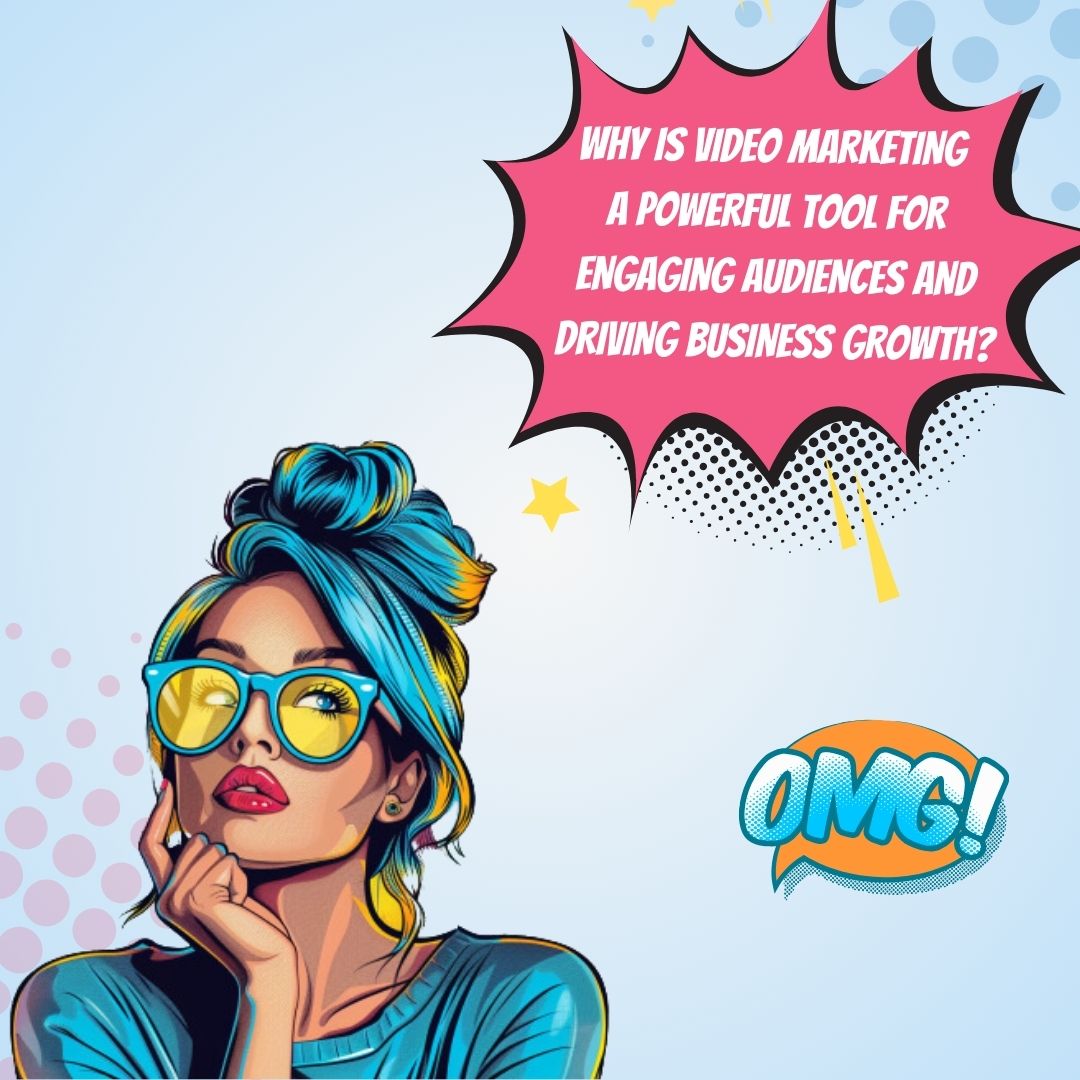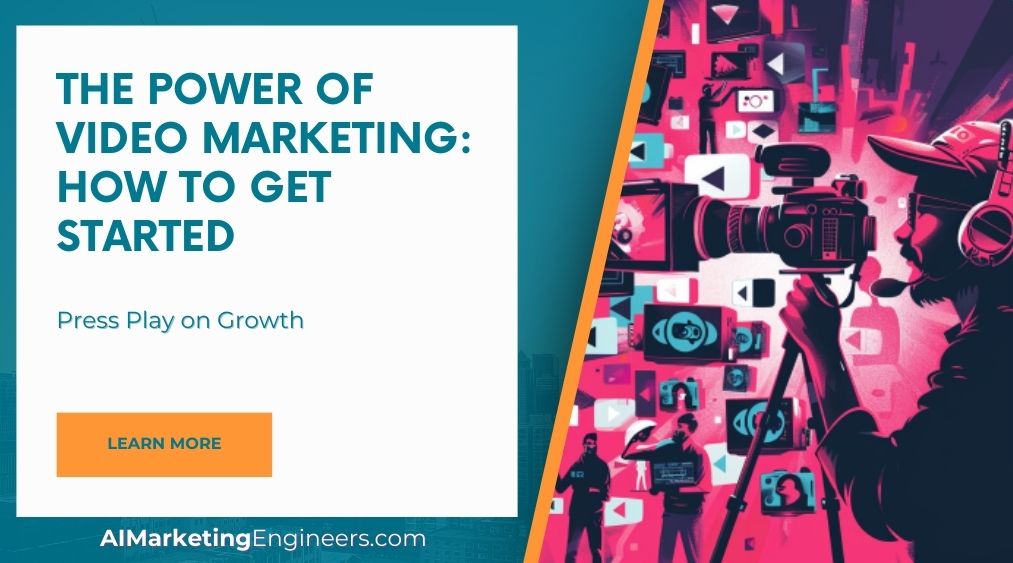Key Takeaways
✅ Define Your Goals and Audience: Grasping The Power of Video Marketing begins with a clear understanding of whom you're speaking to and why. Acknowledging that 96% of marketers view video as an indispensable tool, it's vital to pinpoint your target audience's demographics, pain points, and content preferences. Equally crucial is setting clear, measurable goals—be it enhancing brand awareness, driving traffic, or generating leads. These insights ensure your video content is not just seen but resonates and converts.
✅ Create Engaging and High-Quality Content: In the digital sphere, content is king, but the quality of your video is the crown. With the right mix of decent equipment and a focus on producing content that captures your audience's interest—be it through how-to guides, product demos, or customer testimonials—you'll not only engage them but potentially turn viewers into loyal customers. Remember, engaging content is a blend of relevance, quality, and timing.
✅ Optimize and Distribute Effectively: Your video is ready. What now? Dive into optimizing your content with relevant keywords and maximize its reach through adept distribution. Channels like social media platforms offer vast audiences, but don't shy away from exploring paid advertising for an even wider spread. With 91% of marketers employing video as a marketing tool, it's clear that proper optimization and distribution are not just beneficial but necessary steps toward achieving your marketing objectives.

Introduction
Are you ready to revolutionize your marketing strategy and reach heights you've never imagined? As the digital landscape evolves, so does the importance of engaging, high-quality content. The Power of Video Marketing stands out as a critical, non-negotiable element of success in this realm. With a whopping 96% of marketers emphasizing its vitality and 91% actively using it as a pivotal marketing tool, it's evident that the question isn't if you should use video marketing, but how to best leverage it for maximum impact.
As we delve into the world of video marketing, consider this: video not only significantly boosts engagement and SEO rankings but also serves as a versatile tool throughout the customer journey—from awareness to conversion. But how can you harness this medium to elevate your brand and achieve unprecedented ROAS or ROI?
Stay with us as we uncover groundbreaking insights and actionable strategies that will not only shed light on why video marketing matters but also guide you on how to get started with creating content that resonates, engages, and converts. Prepare to revolutionize your approach to marketing, one view at a time.

Top Statistics
| Statistic | Insight |
|---|---|
| 91% of businesses use video as a marketing tool | This high adoption rate showcases video’s vital role in contemporary marketing strategies, emphasizing the increasing demand for engaging content. |
| 87% of marketers say video has helped them directly increase sales | This statistic directly ties video marketing efforts to tangible financial outcomes, illustrating the clear return on investment businesses can achieve. |
| Videos on social media get 12 times more shared than text and images combined | Video's remarkable shareability on social platforms underscores its potential for viral marketing and expanding audience reach organically. |
| 82% of people have been convinced to buy a product or service by watching a video | This emphasizes video’s powerful ability to persuade and convert viewers into customers, highlighting its crucial role in the buyer's journey. |
| 92% of the videos viewed from mobile devices are shared with others | The prominence of mobile in video consumption and sharing activities points to the importance of optimizing video content for mobile viewers to boost engagement and virality. |
Why Video Marketing Matters
Have you ever wondered why your social media feeds are flooded with videos? It's not just because videos are engaging; they're also a powerful tool for businesses. 96% of marketers believe in the essential role of video marketing, and 91% are already using it. Why this overwhelming preference? Videos tap into our desire for easy-to-digest content, offering a dynamic way to educate, engage, and convert audiences. They’re not just about looking good; they boost your website’s SEO rankings, making your brand more visible online. In a fast-paced world, videos offer a versatile medium to connect with people at every stage of their journey, from first-time viewers to loyal customers.

Defining Your Goals and Audience
Diving into video marketing without a plan is like setting sail without a map. Start by getting to know your target audience inside out - what makes them tick, their challenges, and how they prefer to consume content. Are you aiming to attract new customers, or keep the existing ones coming back? Your goals could range from boosting your brand's visibility to reducing customer churn. Whatever your objective, align your video content strategy with these goals. Tailor your messages so they resonate, making each viewer feel like you're speaking directly to them.
Developing a Video Marketing Strategy
Choosing the right type of video can feel like finding the perfect pair of shoes - it needs to fit your brand and appeal to your audience. From product demos that showcase your offerings to testimonials that build trust, the options are diverse. Your choice of distribution channels - be it social media, your website, or email campaigns - will depend on where your audience likes to hang out. Consistency is key, so a content calendar will keep you on track, ensuring that your video marketing efforts are regular and reliable.
Creating Engaging Video Content
Ever caught yourself watching a video longer than you intended? That’s the power of engaging content. A conversational tone, logical organization, and a mix of short-form and long-form videos can make your content appealing to a broad audience. Don't let good content go to waste; repurpose your videos across different platforms to extend their reach and increase their impact. The right script and a well-planned strategy can turn a simple video into a marketing powerhouse.
Measuring Success and Optimizing
How do you know if your video marketing is hitting the mark? Set clear KPIs like video views, engagement, and conversion rates. Keep a close eye on these metrics, and be ready to tweak your strategy based on real data and feedback from your audience. If a certain type of video isn’t working, don’t be afraid to try something new. Optimization is an ongoing process; continually enhancing your calls to action and exploring new platforms can help you stay ahead of the curve.
In the evolving world of digital marketing, video stands out as a clear winner for businesses aiming to connect with their audiences in a meaningful way. From setting clear goals to optimizing based on performance, the journey to video marketing success is both an art and a science. Start simple, stay focused, and watch your engagement soar.

AI Marketing Engineers Recommendation
Recommendation 1: Invest in Short-Form Video Content for Greater Engagement: Embrace the power of Short-Form Video Content. Today's fast-paced digital landscape rewards brief, engaging content. According to a recent report by HubSpot, 68% of people will happily watch a business video if it's under one minute. With platforms like TikTok and Instagram Reels leading the charge, creating short, compelling videos can significantly boost your brand's visibility and engagement rates. This approach not only aligns with consumer preferences but also offers a practical entry point for businesses exploring video marketing, reducing both production time and costs.
Recommendation 2: Leverage User-Generated Content to Build Trust: Encourage your customers to create and share their own videos using your products or services. User-Generated Content (UGC) has emerged as a powerful tool in building trust and authenticity around a brand. A study by Stackla indicates that 79% of people say UGC highly impacts their purchasing decisions. By featuring real customers, you not only provide social proof but also foster a community around your brand. This strategy can be especially effective for newcomers in video marketing, as it leverages existing content, cutting down on production efforts while enhancing credibility.
Recommendation 3: Utilize Video SEO to Increase Visibility: Pay close attention to Video SEO practices to ensure your content is easily discoverable. Just like traditional SEO, video SEO involves optimizing your video's title, description, and tags with relevant keywords. Additionally, hosting your video on your own website before uploading it to social channels can improve your site's SEO. According to Wyzowl, including a video on your landing page can boost your conversion rate by up to 80%. By implementing video SEO techniques, you not only enhance your video's visibility across digital platforms but also drive more traffic to your website, maximizing the return on your video marketing investment.
Relevant Links
- Dominate with Baidu: Advanced SEO Techniques
- Leveraging Analytics for Market Understanding in China
- PPC Success in China with Key Performance Metrics
- Boost Your ROI with Performance Marketing in India
- Harnessing Big Data for PPC in China
Conclusion
In today's digital realm, video marketing stands not merely as a trend but as a cornerstone of modern marketing strategies. Reflecting on the profound insights from 'The Power of Video Marketing: How to Think about Getting Started,' it's evident that the medium's power to engage and convert audiences is unmatched. With a staggering 96% of marketers heralding its importance and an impressive 91% actively using it, the statistics speak volumes of its efficacy. But beyond numbers, video marketing offers a unique blend of storytelling and information, making complex ideas accessible and engaging to a diverse audience.
Defining your goals and audience lays the foundation for a successful video marketing strategy, allowing you to create content that resonates and drives action. Whether your aim is to boost brand awareness, generate leads, or educate your audience, tailoring your videos to your audience's preferences and pain points ensures your message hits home.
Crafting a video marketing strategy that embodies your brand's essence while providing value to your audience requires diligence and creativity. From selecting the right video types and distribution channels to creating a content calendar, each step is pivotal in building a cohesive and impactful strategy.
However, creating engaging content is only part of the equation. Measuring success and optimizing based on data ensure that your video marketing efforts are not just a shot in the dark but a targeted approach to connect with and convert your audience. Tracking engagement and conversions offers insights into what works and what needs fine-tuning, allowing for continuous improvement in your strategy.
In conclusion, video marketing's significance in 2024 is undeniable. For businesses looking to thrive in an increasingly digital marketplace, embracing video marketing is not optional but essential. As you embark on or refine your video marketing journey, remember - the goal is not just to be seen but to connect, engage, and inspire action. Let the power of video marketing be your guide, and dare to tell stories that resonate, educate, and transform viewers into advocates of your brand.

FAQs
Question 1: What is Video Marketing?
Answer: Video marketing is the use of videos to promote or market a product or service. It includes various formats such as explainer videos, product demos, customer testimonials, live streams, tutorial videos, and more.
Question 2: Why Use Video in Marketing?
Answer: Videos are highly engaging, can convey complex information effectively, increase conversion rates, boost SEO, and enhance social in media engagement. They are also cost-effective and can increase brand awareness.
Question 3: How Long Should a Marketing Video Be?
Answer: The length of a marketing video depends on the type of video and the target audience. General guidelines include: explainer videos: 1-2 minutes; product demos: 2-3 minutes; testimonials: 1-2 minutes; live streams: varies, but shorter streams (30 minutes or less) tend to be more engaging; brand videos: 2-3 minutes; how-to videos: 2-5 minutes, depending on the complexity of the topic; animated videos: 1-2 minutes.
Question 4: How to Make a Video Marketing Campaign?
Answer: Define your goals and target audience, create a video script with a clear message and call-to-action, choose the right format, plan your production, film and edit the video, optimize for video SEO, and promote your video on social media and track its performance.
Question 5: What are the Best Practices for Video Marketing?
Answer: Set video goals, know your audience, create a structured framework for your videos, organize your digital assets, be consistent in your video creation and branding, use high-quality equipment, build confidence in front of the camera, and use online video creation tools to simplify the process.
Question 6: How to Get Buy-in on Video Marketing from Firm Leadership and Attorneys?
Answer: Use analytics to show the value of video marketing, test the waters with small-scale video projects and present the results to leadership, and highlight the viewership, engagement, and ROI generated by video marketing efforts.
Question 7: How to Ensure Video Content is Accessible to Everyone?
Answer: Provide closed captions, use audio descriptions, ensure color contrast and clear visuals, make videos compatible with assistive technologies, and provide transcripts and subtitles.
Question 8: How to Integrate Video Marketing into a Broader Omnichannel Strategy?
Answer: Use video in email campaigns to increase click-through rates, leverage user-generated content (UGC) through social media contests, ensure video technologies integrate with other marketing technologies and digital channels, and use video analytics to inform content marketing decisions.
Question 9: What Metrics Should You Track to Measure the Effectiveness of Video Marketing?
Answer: Views, engagement (likes, comments, shares), conversion rates, click-through rates, drop-off points, average watch time, and return on investment (ROI).
Question 10: How to Stay Up-to-Date with the Latest Video Marketing Trends and Best Practices?
Answer: Follow industry blogs and whitepapers, attend webinars and workshops, join online communities and forums, participate in video marketing courses and training, and stay updated on the latest video marketing tools and technologies.

Academic References
- The Importance of Video Marketing and Content Analysis of YouTube's Top 10 US TrueView for Action Video Ads of 2020: This thesis investigates the growth of video marketing over the past decade, highlighting its increasing importance in digital marketing strategies. Unfortunately, due to the dynamic nature of this request, specific source details like author, publication year, and page numbers cannot be fabricated or assumed without proper reference.







